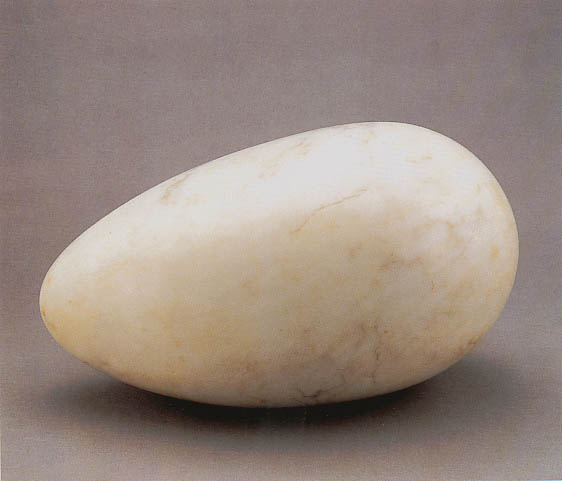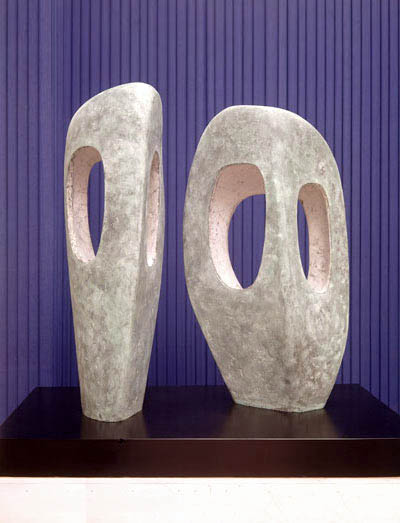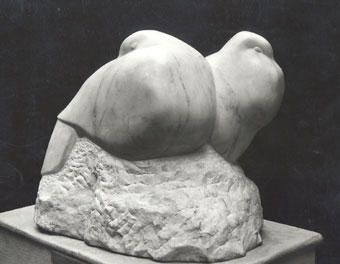May 31, 2011
May 27, 2011
May 26, 2011
May 25, 2011
Hepworth and the 'primal'
Using primitive or platonic shapes
There was a program about Barbara Hepworth on television last week (The Culture Show on BBC), and I have been thinking about it since. It included some black and white footage of Hepworth at work, and audio of Hepworth speaking about herself, her practice, and art in general. I did not see the full show as I had to go out on a previously engaged bike ride. Unfortunately I can not find the show online, but here is another interview by Hepworth:
Perhaps it was a fair sacrifice--giving up the TV program for riding the bike in fresh air--one Hepworth might make herself, considering she was interested in the nature and landscape. She also used a word akin to primitive, primary, primordial, primal, or eternal on the show. I can't be sure which word it was anymore... I am thinking about the primary shapes myself: the circle, triangle, square. I do like them. Plus I find it amazing just how many painters and draftsmen/women are turning to the primitives as a subject. I enjoy their work as well. But a bee buzzes somewhere...
The question of existence,
The question of existence as an artist,
The question of existence of an artwork made by the artist,
Is there an eternal, spiritual, primal, abstract, concentrated answer to these questions? One can 'feel' these questions, and proceed to 'think' of them. To feel their answer in a primary form, a platonic form, a form smoothened or neutralized... I am not sure...
John Berger has a lovely essay on Brancusi and his forms in the book 'The Shape of a Pocket' [121-7]. In describing a blind person's reactions when holding Brancusi's 'Sculpture for the Blind,' Berger imagines them asking, "Is this thing I'm holding a container or a core?" Berger says that when carving Brancusi "wanted to go back, eliminating all imperfections, all wear and tear, to the growing point of the first Creation, to the pure idea as it takes on form. Platonic once more." Berger feels when the sculptor succeeded when he created a core. But Berger brings up the question that Brancusi might himself have felt, i.e. how long can one keep pursuing the platonic?
Hepworth's interviews brought up the word 'primal.' And that brings up for me the search for meaning... it troubles me, or perhaps it calls me... It calls me because I know that question. It troubles me because firstly because the word 'primitive' etc seems to have a colonial ring to it. And also I am realizing that a platonic shape can not exist in reality, it may only seem to exist in representation. And as no perfection is possible... 'perfection' of form is imperfect. [Imperfection as texture or pattern... that is an interesting idea.] Maybe I feel that tool marks on an imagined platonic form are a ruse, not a testimony to a human spirit that is reaching towards that which is perfect. The form really must be imperfect, more unique. Of course it all depends on the point of view, and what carries an urgency on a person to person, situation to situation basis. I need to see and read a bit more about Hepworth to see what she was after. Maybe it will help me figure out the same for me.
There was a program about Barbara Hepworth on television last week (The Culture Show on BBC), and I have been thinking about it since. It included some black and white footage of Hepworth at work, and audio of Hepworth speaking about herself, her practice, and art in general. I did not see the full show as I had to go out on a previously engaged bike ride. Unfortunately I can not find the show online, but here is another interview by Hepworth:
Perhaps it was a fair sacrifice--giving up the TV program for riding the bike in fresh air--one Hepworth might make herself, considering she was interested in the nature and landscape. She also used a word akin to primitive, primary, primordial, primal, or eternal on the show. I can't be sure which word it was anymore... I am thinking about the primary shapes myself: the circle, triangle, square. I do like them. Plus I find it amazing just how many painters and draftsmen/women are turning to the primitives as a subject. I enjoy their work as well. But a bee buzzes somewhere...
The question of existence,
The question of existence as an artist,
The question of existence of an artwork made by the artist,
Is there an eternal, spiritual, primal, abstract, concentrated answer to these questions? One can 'feel' these questions, and proceed to 'think' of them. To feel their answer in a primary form, a platonic form, a form smoothened or neutralized... I am not sure...
John Berger has a lovely essay on Brancusi and his forms in the book 'The Shape of a Pocket' [121-7]. In describing a blind person's reactions when holding Brancusi's 'Sculpture for the Blind,' Berger imagines them asking, "Is this thing I'm holding a container or a core?" Berger says that when carving Brancusi "wanted to go back, eliminating all imperfections, all wear and tear, to the growing point of the first Creation, to the pure idea as it takes on form. Platonic once more." Berger feels when the sculptor succeeded when he created a core. But Berger brings up the question that Brancusi might himself have felt, i.e. how long can one keep pursuing the platonic?
 |
| Constantin Brancusi Sculpture for the Blind ca. 1920 Veined Marble |
Hepworth's interviews brought up the word 'primal.' And that brings up for me the search for meaning... it troubles me, or perhaps it calls me... It calls me because I know that question. It troubles me because firstly because the word 'primitive' etc seems to have a colonial ring to it. And also I am realizing that a platonic shape can not exist in reality, it may only seem to exist in representation. And as no perfection is possible... 'perfection' of form is imperfect. [Imperfection as texture or pattern... that is an interesting idea.] Maybe I feel that tool marks on an imagined platonic form are a ruse, not a testimony to a human spirit that is reaching towards that which is perfect. The form really must be imperfect, more unique. Of course it all depends on the point of view, and what carries an urgency on a person to person, situation to situation basis. I need to see and read a bit more about Hepworth to see what she was after. Maybe it will help me figure out the same for me.
 |
| Barbara Hepworth, Two Forms in Echelon, Bronze, 1961 |
 |
| Barbara Hepworth, Doves (Group), Parian marble, 1927 (BH 3), Manchester City Art Gallery |
May 24, 2011
studio may 24 stitching rosebush
I am learning to trim and help my rose bush. The days are bright and sunny. The thorns are scratchy, and the the rose bush may have found its way into my work today. I am tying the unruly branches with twine so that they find support in each other and the wall... I don't know if this is the way it is usually done. I still have a long way to go.
Also I started to stitch my paper pieces instead of gluing them down to each other. I like the fluidity the thread gives. I think there is some important connection the thread has to textile and even to travel. I recently wrote an artist statement (artist statements are so helpful in clarifying one's ideas.) In it I wrote that in traveling one gathers many residual and absurd bits of things: memories of spoken words or textiles, ticket stubs, wrappers, or single socks. I use my older paper works to collage. There is some connection...
May 20, 2011
May 19, 2011
May 17, 2011
Old Posts Reposted
what makes art 'art', is the move in its makers heart--the move that suggests the art/gesture should be gathered out of its context so it can stand independently. This makes it possible to look at the gesture carefully, consider it in isolation, in the context it occurred in, and other related and unrelated contexts.
'jan 02 definitions'
negative:
fear (v. caused by unstable center)
dominion (n. desire of an ego)
lagging (v. uneven pacing between action and ideal)
semi-negative:
cater (v. act according to the wishes of others)
force (n. used to get what is desired)
counter (v. argue by negating)
course (n. pre-plan)
motion (n. undignified)
lover (n. preconceived)
neutral:
culture (n. illusion of real bonds)
round (n. mimicking shape of circle)
cavern (n. dark cave)
dual:
demon (n. physical form of fear)
positive:
less (editing to find only that which is required)
doubt (n. act of being unsure)
shringar:
lips
eyes
ears
fingers
cheeks
nose
wrists
ankles
toes
waist
neck
negative:
fear (v. caused by unstable center)
dominion (n. desire of an ego)
lagging (v. uneven pacing between action and ideal)
semi-negative:
cater (v. act according to the wishes of others)
force (n. used to get what is desired)
counter (v. argue by negating)
course (n. pre-plan)
motion (n. undignified)
lover (n. preconceived)
neutral:
culture (n. illusion of real bonds)
round (n. mimicking shape of circle)
cavern (n. dark cave)
dual:
demon (n. physical form of fear)
positive:
less (editing to find only that which is required)
doubt (n. act of being unsure)
shringar:
lips
eyes
ears
fingers
cheeks
nose
wrists
ankles
toes
waist
neck
CoBrA Museum & Guerrilla Art Classes
 |
| Piet Ouborg, Luisterend in beweging 1948, oil on canvas, 60 x 90,5 cm |
I visited the Cobra Museum (close to Amsterdam) on Sunday. It was such a treat to visit a museum and see some powerful paintings. I learned quite a bit about the revolutionary CoBrA avante-garde movement started by artists from 'Co'penhagen, 'Br'ussels, and 'A'msterdam, active from 1949-51. The movement marked a conscious break from traditional art in the Netherlands and hence was rather influential. I love their free use of form and color, and especially their borrowing from Paul Klee--who has always been rather a favorite of mine.
Also, it was very helpful to see some paintings in person instead of just online. When you see a painting in person, you can move close and away, be more aware of texture, and scale. Personally I realized how differently everyone uses texture, and that some people can push texture to an emotional plane. Strange I just wrote 'people' and not 'artists.' In fact, somewhere, in a brochure or a museum writeup, one of the Cobra artists had been quoted saying something like, "We have to get everyone painting. Everyone is a painter, whether they know it or not..." I realized the group was quite revolutionary when I read that! It made me smile too (I imagined breaking into a bank/ military base, holding everyone on gunpoint, demanding they each paint a painting right then and there. A guerrilla art class.)
 |
| Lucebert, Spanish dance, 1961, oil on canvas, 100 x 150 cm |
 |
| Constant, Two Birds, 1949 oil on canvas, 82 x 63 cm |
 |
| Egill Jacobsen, Rød maske, 1943 oil on canvas, 85 x 65 cm |
May 16, 2011
May 13, 2011
Subscribe to:
Posts (Atom)






































